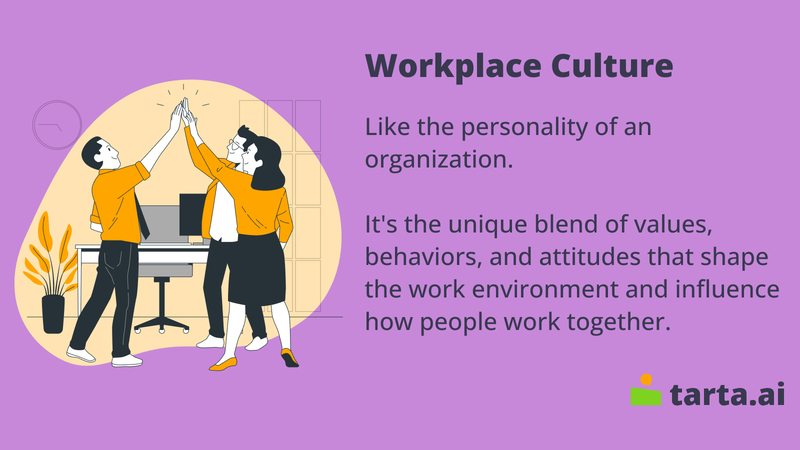Understanding Workplace Culture: What It Is and Why It Matters

The culture of a workplace plays a crucial role in determining the success of an organization. Workplace culture refers to the shared values, beliefs, attitudes, and behaviors that shape the environment and interactions within an organization. It encompasses everything from the way people communicate and collaborate to the company's mission and goals. In short, workplace culture is the personality of an organization.
Why is workplace culture important? Because it sets the tone for how employees interact with each other and how they approach their work. A positive workplace culture fosters collaboration, innovation, and productivity. It can also improve employee morale, engagement, and retention. On the other hand, a negative workplace culture can be toxic and damaging to employee well-being and organizational success.
In this article, we will explore what workplace culture is, why it matters, and how it can impact an organization and its employees. We will also discuss strategies for creating a positive workplace culture and the risks associated with negative workplace cultures.
Defining Workplace Culture
To better understand workplace culture, let's break down its definition, elements, and examples.
As mentioned in the introduction, workplace culture refers to the shared values, beliefs, attitudes, and behaviors that shape the environment and interactions within an organization. It is the underlying personality of a workplace that influences everything from employee satisfaction to customer experience.

There are several elements that shape workplace culture, including:
- Leadership: The values and behaviors of leaders set the tone for the entire organization.
- Communication: The way people communicate and collaborate with each other influences workplace culture.
- Employee engagement: The level of employee engagement and involvement in decision-making processes affects workplace culture.
- Diversity and inclusion: The level of diversity and inclusion in the workplace can either foster or hinder a positive workplace culture.
- Mission and values: The company's mission and values reflect the culture and can influence employee behavior.
Workplace culture can be observed in many ways. For example:
- Dress code: The level of formality in dress code can reflect the culture of a workplace.
- Office design: The layout and decor of an office can reflect the values and personality of an organization.
- Employee behavior: The way employees interact with each other and with customers can reflect workplace culture.
- Corporate social responsibility: The level of social responsibility and community involvement can reflect the culture of a workplace.
Overall, workplace culture is a complex and multifaceted concept that shapes the behavior and interactions of everyone in an organization.
The Impact of Workplace Culture
Workplace culture has a significant impact on employee performance, productivity, morale, and retention.

Photo: fauxels/Pexels
How workplace culture impacts employee performance and productivity?
When employees feel connected to their work and their colleagues, they are more likely to be productive and perform at a high level. Positive workplace cultures can also encourage employees to take ownership of their work and collaborate with others, leading to more innovative and efficient processes.
The connection between workplace culture and employee morale
Employees who feel supported, respected, and valued in their workplace are more likely to have high morale. Positive workplace cultures can create a sense of community and belonging among employees, which can improve their motivation and satisfaction.
The relationship between workplace culture and employee retention
Employees are more likely to stay with an organization that has a positive workplace culture. When employees feel that their contributions are valued, and their well-being is prioritized, they are more likely to remain committed to the organization and its goals.
Interesting fact:
Organizations with positive workplace cultures have employees who are 12% more productive than those in organizations with negative cultures.
On the other hand, a negative workplace culture can have the opposite effect. Employees who feel unsupported, undervalued, and disconnected from their work and colleagues are more likely to be disengaged, unproductive, and unhappy. This can lead to increased turnover and decreased organizational success.
Workplace culture can have a significant impact on an organization's performance and employee well-being.
Creating a Positive Workplace Culture
Creating a positive workplace culture is crucial for organizational success. Here are some strategies for developing a positive workplace culture:
Strategy | Description |
Establish a clear mission and values | Develop a mission statement and core values that reflect the culture you want to create. |
Foster open communication | Encourage open and honest communication between employees and leadership. |
Prioritize employee well-being | Create a workplace environment that supports employees' physical, mental, and emotional well-being. |
Embrace diversity and inclusion | Create a workplace culture that values diversity and promotes inclusivity. |
Recognize and reward positive behavior | Celebrate and reward employees who embody the desired workplace culture. |

Photo: fauxels/Pexels
The role of leadership in shaping workplace culture
Leadership plays a critical role in shaping workplace culture. Leaders must model the behaviors and values they want to see in their employees. They must also be transparent and accountable, and prioritize the well-being of their employees.
Employee feedback is essential for improving workplace culture. Employers should regularly seek feedback from their employees and use that feedback to make improvements. This can be done through surveys, focus groups, or one-on-one meetings.
Creating a positive workplace culture is an ongoing process that requires commitment and effort from everyone in the organization. By following these strategies and taking a proactive approach to workplace culture, employers can create a work environment that fosters productivity, innovation, and employee well-being.
The Risks of a Negative Workplace Culture
A negative workplace culture can have serious consequences for both employees and the organization. Here are some examples of negative workplace culture:
- Toxic work environment: A work environment where bullying, harassment, and discrimination are present.
- High turnover rates: A sign of employees feeling unhappy and unsupported in their work environment.
- Low employee engagement: A lack of motivation and commitment among employees towards their work and the organization.
- Poor communication: A work environment where there is a lack of transparency and clear communication between employees and leadership.
- Lack of work-life balance: A work environment that does not prioritize employee well-being and personal time.
Negative workplace cultures can cause stress, anxiety, and other mental health issues in employees. This can lead to decreased productivity, absenteeism, and turnover.
Negative workplace cultures can also have significant consequences for the organization, including decreased productivity, lower employee retention rates, and damage to the organization's reputation. This can ultimately impact the organization's bottom line.
It is essential for employers to be aware of the risks of negative workplace culture and take proactive steps to prevent and address it. This can include creating policies and procedures to address toxic behaviors, fostering open communication and feedback, and prioritizing employee well-being. By creating a positive workplace culture, employers can create a work environment that supports employee success and organizational growth.

Photo: fauxels/Pexels
In conclusion, workplace culture is a critical aspect of any organization's success. A positive workplace culture can improve employee productivity, engagement, and retention, while a negative culture can have the opposite effect. It is crucial for employers to prioritize workplace culture and take proactive steps to create a positive work environment that supports employee well-being and organizational success.
To improve workplace culture, employers can implement strategies such as fostering open communication, prioritizing employee well-being, embracing diversity and inclusion, and recognizing and rewarding positive behavior. Leadership plays a critical role in shaping workplace culture, and employee feedback is also essential for making improvements.
In today's competitive job market, organizations that prioritize workplace culture are more likely to attract and retain top talent. By creating a positive workplace culture, employers can improve employee satisfaction and performance, leading to increased productivity and growth.
It is time for employers to take action and prioritize workplace culture. By doing so, they can create a work environment where employees feel valued, supported, and motivated to succeed.
- Workplace culture is the shared values, beliefs, and behaviors that shape an organization's work environment.
- A positive workplace culture can improve employee performance, engagement, and retention, while a negative culture can have the opposite effect.
- Strategies for developing a positive workplace culture include establishing a clear mission and values, fostering open communication, prioritizing employee well-being, embracing diversity and inclusion, and recognizing and rewarding positive behavior.
- Leadership plays a critical role in shaping workplace culture, and employee feedback is essential for making improvements.
- Negative workplace cultures can have significant consequences for employee well-being and organizational success, including decreased productivity, lower employee retention rates, and damage to the organization's reputation.
FAQ
What are some signs of a toxic workplace culture?
Some signs of a toxic workplace culture include high turnover rates, low morale, poor communication, lack of trust, favoritism, discrimination, harassment, bullying, and a lack of work-life balance.
How can a toxic workplace culture be addressed?
A toxic workplace culture can be addressed by identifying the root causes, addressing the issues through open communication and transparency, holding leaders and managers accountable, providing training and education, and promoting a safe and inclusive working environment.
How can workplace culture be measured?
Workplace culture can be measured through employee surveys, focus groups, one-on-one interviews, performance metrics, and other forms of feedback and evaluation.
What are some common challenges in building a positive workplace culture?
Some common challenges in building a positive workplace culture include resistance to change, lack of leadership support, competing priorities, and limited resources.